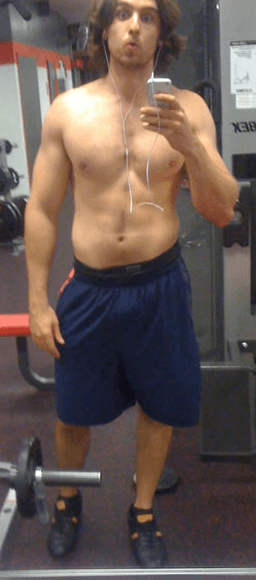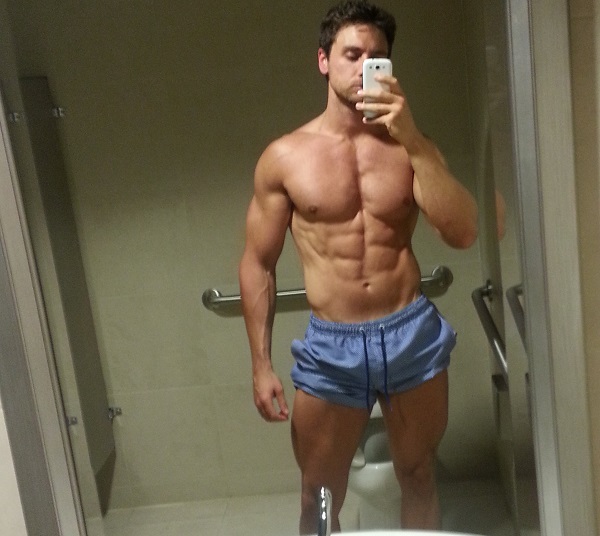Just a few years ago, I was small (for how long I had been lifting), weak, fat, and completely stuck in a rut.
For nearly 7 years, I bounced from one magazine workout to another… spent close to 2 hours in the gym every day… wasted hundreds of dollars per month on supplements … and this is what it got me:

As you can imagine, I wasn’t very thrilled.
I was so used to my routine that I just went through the actions every day, but I was certain I just didn’t have the genetics to look good or get really strong, and that even if I did, I thought it would require steroids.
It turns out I was wrong.
I was just making a some of the worst (and most common) fitness mistakes out there, and once I started doing things correctly, everything changed, quickly and dramatically.
Here’s what I mean:

Believe it or not, I made that transformation by spending less time in the gym every day, by doing less cardio, and by following an all-around more enjoyable diet.
It sounds too good to be true–I know.
But in this article, I’m going to share with you the 5 huge fitness mistakes I was making that were preventing me from achieving my true genetic potential in terms of strength, muscle growth, and overall development and conditioning.
Table of Contents
+
Huge Fitness Mistake #1:
Focusing on high-rep “burnout” workouts.

Back when I didn’t know what I was doing, here was a normal Chest Day workout:
Flat Smith Machine Press: 4-5 sets of 10-12 reps
Flat Dumbbell Press: 4-5 sets of 10-12 reps
Decline Bench Press: 4-5 sets of 10-12 reps and supersetted with push-ups to failure
Dumbbell Flyes: 2-3 drop sets to failure
After years and years of that type of training, my chest did grow, but it was very slow, and I was pretty pathetically weak (I couldn’t even rep 225 on the freeweight flat bench…after 7 years of lifting…yikes).
What I didn’t know is that high-rep training with an emphasis on “feeling the burn” should never be the focus of a natural weightlifter.
Why?
Because that style of training does not build the strong, dense type of muscle we’re after. Instead, it gives big pumps but little muscle growth.
What should we be doing then? Us natural weightlifters should focus on lifting heavy weights with a moderate workout volume (40 – 60 reps per muscle group every 5 – 7 days)
The single rep range I’ve found most effective is the 4 – 6 rep range, which has you lifting about 80 – 85% of your one-rep max. This rep range is an incredibly effective way to stimulate both myofibrillar and sarcoplasmic hypertrophy, resulting in big, dense, strong muscles that don’t disappear when your pump subsides or when you get lean.
Trust me on this one–the big, shredded guys that do 15-25 sets per workout, 10-12+ reps per set, with supersets, drop sets, and other fancy rep schemes, can only look like they do because of drugs.
You, as a natural weightlifter, will get nowhere with their routines. It took me years of spinning my wheels to learn this.
Huge Fitness Mistake #2:
Doing too many isolation exercises, and too few compound exercises.

This mistake is a natural outgrowth of the last, as the high-rep burnout workouts almost always have you doing a bunch of isolation work.
In case you’re not familiar with the term, an isolation exercise is an exercise that mainly involves one muscle group (it isolates it). For instance, a dumbbell front raise is an isolation exercise that targets your anterior (front) deltoid muscle.
The opposite of an isolation exercises is a compound exercise, which is one that involves multiple muscle groups. For example, my favorite compound exercise for shoulders is the Military Press (the Standing Overhead Press is good too).
So, in my old workouts, probably 70-75% of my reps were isolation exercise reps. and I almost never did compound exercises vital to building a big, strong physique such as the Deadlift, Squat, and Military or Overhead Press.
Isolation work has a place in a natural weightlifter’s workout routine–I don’t completely shun it like some gurus–but it should never constitute the majority of reps performed in workouts.
The bottom line is compound exercises should be the bulk of your workouts, even if you’re an advanced weightlifter.
Huge Fitness Mistake #3:
Following silly dietary protocols instead of regulating caloric intake.

I more or less had everything wrong when it came to diet.
Here’s a quick rundown of how clueless I was:
- I thought “bad carbs” made you fat.
- I thought fat loss had something to do with “eating clean,” which meant restricting all kinds of foods I ate.
- I thought I had to eat absurd amounts of protein every day to build muscle.
- I thought I would lose muscle if I didn’t eat protein every few hours.
- I thought eating too few meals per day slowed down my metabolism, and could even cause my body to go into “starvation mode.”
- I thought eating at night caused fat storage.
I could go on but, well, you get the idea. I basically had my PhD in brosience.
Thanks to my many misconceptions, my food intake in terms of numbers was all over the place, and my dietary schedule was very inflexible, and very annoying.
While my protein intake was always high (too high, really), I didn’t have any idea how many calories I was eating every day, nor where they were coming from in terms of protein, carbs, and fat. I would just eat a bunch of “bodybuilder foods” like chicken, brown rice, and sweet potato, and hope I grew.
When it came to meal frequency and timing, I was equally bad. I could only eat certain foods at certain times, I had to eat food every 2-3 hours or I would actually get angry (“LOOOSING MY GAINNNZZZ!”), I couldn’t eat dinner past 7 PM, and on and on.
Well, here’s what I’ve learned since:
The nutrition side of the game is horribly simple: you hit exact numbers of grams of protein, carbohydrate, and fat every day, and your body responds by building muscle or losing fat accordingly.
[tweet “Nutrition is very simple: hit exact numbers of grams of protein, carbs, and fat every day.”]
In the end, it all boils down to “energy balance,” which refers to how much energy you’re giving your body with food versus how much you’re expending through basic physiological functions and moving.
Building muscle efficiently requires you give your body a bit more energy (calories) than it requires, and losing fat requires that you give it a bit less.
That’s the bottom-line truth.
With the minor exception of pre- and post-workout nutrition, when you eat food doesn’t help or hinder you.
Meal frequency and timing are irrelevant when it comes to building muscle and losing fat.
[tweet “Meal frequency and timing are irrelevant when it comes to building muscle and losing fat.”]
Where they DO matter is in helping you stick to your plan.
If you prefer 3 meals per day instead of 7, do it that way. If you’re like me and prefer the opposite, that’s okay too. If you like eating an early dinner at 5 PM, great. If you get home last and can’t get dinner ready before 8 PM, that’s totally fine.
So long as you hit your daily numbers, how you get there isn’t important.
While I DO recommend eating a lot of healthy, nutritious foods, WHAT you eat every day doesn’t matter in terms of body composition–it’s all about HOW MUCH you eat.
Would you believe that you could eat Twinkies, Nutty bars, and powdered donuts every day and lose weight?
Well, Professor Mark Haub did just that and lost 27 pounds in 10 weeks.
How the hell is that possible?
Simple: he regulated HOW much of these foods he was eating every day in terms of calories, and just ensured he was feeding his body less energy than it was burning.
What happens when you do this? Weight loss. Even when the calories (energy) are completely devoid of nutrition.
Huge Fitness Mistake #4:
Failing to progressively overload my muscles.

I once believed that the key to stimulating muscle growth was regularly changing up my workout routine. I thought I had to do different exercises every week or two or my body would adapt and no longer grow bigger or stronger.
I was horribly wrong.
What I didn’t know is the key to building bigger, stronger muscles is not doing a bajillion different exercises, but is simply progressively overloading the muscles.
[tweet “Building bigger muscles requires progressive overload, not a constantly changing routine.”]
In case you don’t know, “progressive overload” refers to progressively increasing tension levels in the muscle fibers over time. That is, adding weight to the bar, progressively lifting heavier and heavier weights over time.
This mistake only made the first mistake (high-rep training) even worse. I wasn’t really getting stronger. Instead of moving up in weight, I was more inclined to move up in reps (to get an even bigger pump).
Well, here’s a simple rule of thumb for us natural weightlifters: if you want to get bigger, you have to get stronger.
[tweet “The rule of thumb for natural weightlifters: to get bigger, you have to get stronger.”]
Yes, muscles can get stronger without getting bigger (thanks to neuromuscular adaptations), but there comes a point where additional strength requires bigger muscle fibers, and progressive overload is the key to making that happen.
What this means in practice is that you should move up in weight once you reach the top of the rep range you’re working in.
For example, if you’re training in the 4-6 rep range and get 6 reps on your first set of an exercise, you move up in weight (5 pounds if using dumbbells, 10 pounds if it’s a barbell exercise).
You then work with this new weight, with which you’ll likely get 4 reps on the next set, until you can lift it for 6 reps (this may take one week or three depending on the exercise and how advanced of a lifter you are), after which point you move up, and on it goes.
In this way, you will lift heavier and heavier weights over time, and will be using progressive overload to your advantage.
Huge Fitness Mistake #5:
Not tracking my progress.

I never used to bother logging what I did in my workouts. I just hit the gym every day, decided which exercises I felt like doing, and went at it. The major problem this caused is I never really knew if I was making progress on my lifts.
Now that you know the importance of progressive overload, I’m sure you get the point here. If you don’t have a record of your lifts every week, you have no idea if you’re getting weaker or stronger, and you aren’t able to set goals for your workouts.
The latter point is worth elaborating on.
Your goal, every time you hit the gym, is to do a little better on your exercises than the last time you did them.
[tweet “Your goal every workout is to do a little better on your exercises than the last time.”]
That is, maybe you can’t go up on your Bench Press weight this week, but if you can beat last week’s press by just one rep, that’s a successful workout. If you can then beat that number by another rep the following week, then you’re ready to move up in weight.
The only way to systematically do this is to log what you do in the gym each week, and use these records to guide your future workouts.
This is Only the Beginning of My Many Fitness Mistakes…

This is really only the beginning–I was making many more mistakes that needed fixing.
- I was wasting my time with a bunch of sub-par exercises. (Some exercises are just more effective than others.)
- My training frequency was poorly laid out. (I was overtraining certain parts of my body and undertraining others.)
- I was doing too much cardio, both too frequently and for too long each session. (This is a great way to hinder muscle growth or even lose muscle.)
- My macronutritional ratios were all wrong. (I was way too high in protein and fats, and way too low in carbs.)
- And more…
Looking back, I’m a little surprised I didn’t throw in the towel somewhere around year 4-5, when I was fully plateaued, failing to make any progress in terms of strength, size, or body fat percentage.
Well, the good news is I finally sorted it all out, which not only led to me rapidly building the body I had always wanted, but led to my career as an author, and the chance to help others overcome these same, all-too-common issues.
While I talk about many different things in my articles here on the site, I lay all the key information out for you in my books Bigger Leaner Stronger (for men) and Thinner Leaner Stronger (for women).
If you want to know exactly how to avoid the 5 major pitfalls discussed in this article, and the many others not, then I highly recommend you read either Bigger Leaner Stronger or Thinner Leaner Stronger.
In these books, I teach you EXACTLY what you need to know to rapidly and easily build muscle and lose fat, and nothing else. In just a few hours, these books will teach you things most people will never know about building a strong, muscular, lean, healthy body, and maintaining it for the rest of your life.










